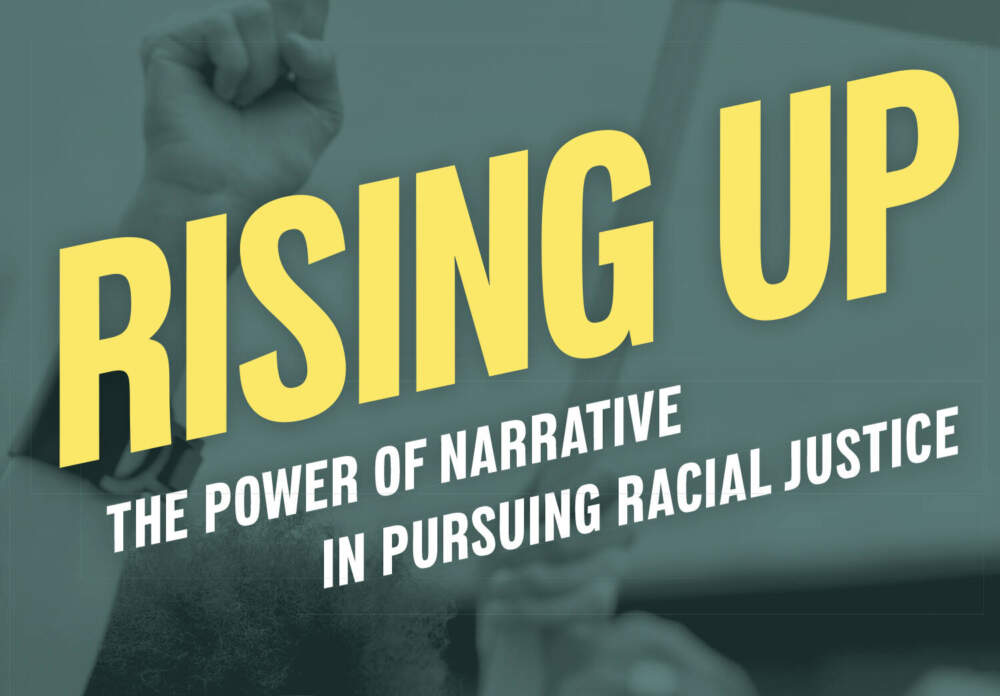Advertisement
Sonali Kolhatkar's new book promotes 'Rising Up' to change narratives about race

Host Deepa Fernandes speaks with journalist Sonali Kolhatkar about her new book "Rising Up: The Power of Narrative in Pursuing Racial Justice." In it, she explores the narratives about race that we encounter in the news media, where they came from, and how to rewrite them.

Book excerpt: 'Rise Up'
By Sonali Kolhatkar
Narrative Power: How Black and Brown Filmmakers are Infiltrating Hollywood
The narratives around race that television and film produce influence how Americans perceive and relate to one another. But just as our screens can foster narratives that reinforce racial hierarchies, they can also be used to promote ones that dissolve them. We can, and should, think of television and movies as useful tools for narrative work and consciousness-shifting on a mass scale.
What’s heartening is that that Black, Brown, and Indigenous creators are increasingly pushing their way into Hollywood in ways that are slowly, but surely, changing our culture.
Humanizing People Targeted by Police Brutality
Before he made the superhero blockbuster Black Panther, filmmaker Ryan Coogler released the feature-length film Fruitvale Station, a searing portrait of a real-life figure, a young Black man named Oscar Grant who was killed by a white police officer at the Fruitvale BART station in Oakland, California, on New Year’s Day, 2009. Coogler, who is a native of Oakland, cast Michael B. Jordan as Grant in the 2013 film. (Jordan went on to become famous for his role as Erik Killmonger in Black Panther.)
Advertisement
Coogler shot the film in the style of a documentary, focusing largely on Grant’s last day of life as he went about his daily routine: a morning cuddle with his girlfriend and daughter, a drive to the grocery store to buy crabs for his mother (played by Octavia Spencer), a quest to figure out how to pay rent, a stop at his mother’s birthday party, and then, a final excursion to San Francisco with friends to celebrate the New Year. In a radio interview about Fruitvale Station, Coogler told me, “My intention was to show who Oscar was to the people that knew him the best.” He added, “So often in
the media, young African American males are shown in very shallow ways . . . that aren’t 360 degrees.” Coogler was especially concerned that Black men, are “rarely shown in ways that are outside of being criminals.”
That is not to say that he wanted to portray only perfect characters—rather, he was interested in three-dimensional, complex ones. In Fruitvale Station, Coogler exposes viewers to a brief flashback from Grant’s life a year earlier when he had been imprisoned, saying, “That flashback scene was about showing Oscar at his lowest point.” Coogler’s intention was to show what Grant’s biggest fear was at the time, which was “going back to prison.”
Most notably, Coogler balanced his storytelling with the strong relationships that Grant had with numerous women in his life: his mother, his girlfriend, and his daughter. “When he was shot on that platform, you can hear on the footage, the first thing he said is, ‘I got a daughter.’ That was the most important person in his life,” said Coogler. “In media representations of young Black males, you don’t often see that side. They’re kind of looked at as being these wayward characters who get girls pregnant, but they’re not fathers,” said Coogler. “Oscar”—like many others—“was a father.”
As the film progresses, anticipating Grant’s inevitable end at the hands of police creates a palpable tension with each seemingly trivial moment in the last day of the young man’s life, humanizing him and forcing viewers to confront the imminent loss of a man they could now imagine knowing intimately.
In choosing not to focus on the aftermath of the police killing, which became highly politicized and prompted mass protests, Coogler instead emphasizes the quiet complexity and depth of the life that was lost, refusing to let Oscar Grant become a mere statistic in the deadly and ongoing tally of racist police violence.
“There’s thousands of Oscar Grants, there’s thousands of young males losing their lives to senseless violence in our streets constantly,” said Coogler, who was only twenty-seven years old when he made Fruitvale Station. The film went on to win the Grand Jury Prize and the Audience Award at the Sundance Festival. It would be hard to imagine someone other than Coogler making the film—about a young Black man just like him, hailing from the same city, being attacked by cops in a
neighborhood he was intimately familiar with. Hollywood’s white creators were simply not capable of making such a film in 2013, nor were they, at that time, interested in projects that humanized the Black victims of police brutality.
Not Waiting for Hollywood’s Validation In 2011, I interviewed another Black filmmaker who was little known at the time and who would also go on to become a household name. Ava DuVernay was promoting her independent film I Will Follow as well as a nonprofit venture she had just launched to promote Black independent films.
Joining me at the studios of KPFK Pacifica Radio in Los Angeles, DuVernay explained that her work was a way to “present African American characters as we are: regular people who live and breathe and die and love, and do so in the way that everyone does.” She made I Will Follow in that vein, centering on a Black woman named Maye who packs up her deceased aunt’s home and takes stock of her life. DuVernay drew from her own experiences to write the screenplay.
Reflecting on the challenges facing Black filmmakers at the time, DuVernay proudly explained that I Will Follow would have a theatrical release in multiple markets across the country: “This is the first time ever—ever, ever, ever—that a simultaneous national theatrical release has happened purely through grassroots means.” Lacking the massive marketing budgets of big production companies at the time, DuVernay had to rely on what she called the “passion and elbow grease” of a small army of supporters who used every means at their disposal—from Facebook posts to leafleting to doing interviews on independent media outlets like KPFK—to promote the film.
When I asked her how much of a challenge it was for independent filmmakers of color like her to contend with an industry wary of projects without white, male leads, DuVernay responded presciently, saying, “We have masses of Black people who are starving for imagery. Why are we looking over there for them [white Hollywood] to validate and to give us permission to distribute our pictures?”
She went on to explain, “I am not interested in pitching my films to studios, I am not interested in raising money with big corporations. I’m not interested in waiting for them to give me permission to distribute my images.”
Freeing herself from the constraints of mainstream Hollywood that would have her create projects designed to appeal primarily to white audiences, DuVernay found her footing in independent spaces and refused to compromise her vision. That approach eventually paid off.
A mere three and a half years after I spoke with her, DuVernay released the film that put her on the national and international film- making map: Selma, about a pivotal chapter in the life of Dr. Martin Luther King Jr. It was her first major studio film and it went on to garner her a Best Picture nomination at the 2015 Academy Awards and more than $50 million in box office sales. In 2019, DuVernay explained in a Twitter thread the long and arduous road she had traveled to make it to that moment, including using up all her savings, bartering for film equipment, being denied numerous opportunities, and still persisting in an industry that for too long has excluded people of color. Her organization, ARRAY, offers a model for filmmakers from other racial groups to do the same. ARRAY has gone on to release dozens of films by various Black filmmakers since I Will Follow.
Growing numbers of Black filmmakers are now forcing their way into the national movie market. These artists demonstrate that creating for audiences of color matters. Where once only a handful of Black filmmakers, such as Spike Lee and John Singleton, could get major projects greenlit, today their ranks have increased to include DuVernay, Ryan Coogler, Jordan Peele, Boots Riley, Kasi Lemmons, Issa Rae, and many, many others.
While it’s a good start, much work remains to be done to improve representation of Black people on-screen as well as that of Indigenous people, Latinos/as, and Asian Americans.
Excerpted from "Rising Up: The Power of Narrative in Pursuing Racial Justice" by Sonali Kolhatkar. Copyright © 2023 by Sonali Kolhatkar. Reprinted with the permission of City Lights Books.
This segment aired on August 3, 2023.